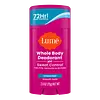What's inside
What's inside
 Key Ingredients
Key Ingredients

 Benefits
Benefits

 Concerns
Concerns

 Ingredients Side-by-side
Ingredients Side-by-side

Water
Skin ConditioningAluminum Sesquichlorohydrate
AstringentMaranta Arundinacea Root Powder
Skin ConditioningIsoamyl Laurate
EmollientMandelic Acid
AntimicrobialHydroxypropyl Starch Phosphate
Cetearyl Alcohol
EmollientTapioca Starch
Caffeine
Skin ConditioningCaprylic/Capric Triglyceride
MaskingHydrogenated Castor Oil
EmollientBehenyl Alcohol
EmollientTheobroma Cacao Seed Butter
EmollientAloe Barbadensis Leaf Juice
Skin ConditioningHelianthus Annuus Seed Oil
EmollientPanthenol
Skin ConditioningTocopherol
AntioxidantStearyl Alcohol
EmollientDimethicone
EmollientPentylene Glycol
Skin ConditioningSodium Benzoate
MaskingPotassium Hydroxide
BufferingAllantoin
Skin ConditioningTetrasodium Glutamate Diacetate
Water, Aluminum Sesquichlorohydrate, Maranta Arundinacea Root Powder, Isoamyl Laurate, Mandelic Acid, Hydroxypropyl Starch Phosphate, Cetearyl Alcohol, Tapioca Starch, Caffeine, Caprylic/Capric Triglyceride, Hydrogenated Castor Oil, Behenyl Alcohol, Theobroma Cacao Seed Butter, Aloe Barbadensis Leaf Juice, Helianthus Annuus Seed Oil, Panthenol, Tocopherol, Stearyl Alcohol, Dimethicone, Pentylene Glycol, Sodium Benzoate, Potassium Hydroxide, Allantoin, Tetrasodium Glutamate Diacetate
Aluminum Sesquichlorohydrate
AstringentPPG-15 Stearyl Ether
EmollientOzokerite
Emulsion StabilisingNeopentyl Glycol Diheptanoate
EmollientStearyl Alcohol
EmollientIsododecane
EmollientIsopentyldiol
HumectantLauryl Laurate
Skin ConditioningMandelic Acid
AntimicrobialSorbitan Oleate
EmulsifyingMaranta Arundinacea Root Powder
Skin ConditioningSilica
AbrasiveCitronellyl Methylcrotonate
MaskingZea Mays Starch
AbsorbentEthylhexylglycerin
Skin ConditioningPanthenol
Skin ConditioningCaffeine
Skin ConditioningAluminum Sesquichlorohydrate, PPG-15 Stearyl Ether, Ozokerite, Neopentyl Glycol Diheptanoate, Stearyl Alcohol, Isododecane, Isopentyldiol, Lauryl Laurate, Mandelic Acid, Sorbitan Oleate, Maranta Arundinacea Root Powder, Silica, Citronellyl Methylcrotonate, Zea Mays Starch, Ethylhexylglycerin, Panthenol, Caffeine
 Reviews
Reviews

Ingredients Explained
These ingredients are found in both products.
Ingredients higher up in an ingredient list are typically present in a larger amount.
We don't have a description for Aluminum Sesquichlorohydrate yet.
Caffeine is most associated with coffee, tea, and cacao. In skincare, it helps with calming inflammation and is rich in antioxidants.
While caffeine is used to treat cellulite and and dark circles, further studies are needed to prove this. It has been believed to help with these skin conditions due to its ability to dilate blood vessels and increase blood flow.
Some studies are looking into caffeine's ability to protect against UV rays.
Learn more about CaffeineMandelic Acid is an alpha hydroxy acid (AHA).
Like other AHAs, it helps exfoliate the surface of the skin by breaking down the bonds that hold dead skin cells together. This helps reveal smoother and brighter skin underneath.
Mandelic acid helps with:
Due to it having a larger molecular size than glycolic acid, mandelic acid is able to penetrate the skin more slowly and evenly. This makes it gentler and less irritating, making it a great option for sensitive or beginner skin.
Despite being milder, mandelic acid is still an effective exfoliant that improves skin texture and tone over time.
What makes mandelic acid stand out from other AHAs? It has antibacterial and antioxidant properties.
These traits make it a great option for acne-prone or problem skin by reducing active breakouts and fading post-acne marks. Studies show that mandelic acid (especially when combined with salicylic acid) can significantly reduce pimples and hyperpigmentation while causing fewer side effects than stronger acids.
Mandelic acid is effective in concentrations of 5% and up with an ideal pH range of 3-4 for at-home use.
Like other AHAs, it’s important to wear sunscreen daily to protect your newly exfoliated skin.
However, unlike glycolic acid, mandelic acid is light-sensitive. Be sure your mandelic acid is packaged in opaque containers to ensure it stays stable and effective.
In short, mandelic acid is a gentle yet powerful AHA that exfoliates, brightens, and helps clarify skin while keeping irritation low. Its antibacterial action makes it especially beneficial for those with acne-prone, sensitive, or uneven skin, offering smoother, clearer, and more even-toned results over time.
Read more about some other popular AHA's here:
Learn more about Mandelic AcidWe don't have a description for Maranta Arundinacea Root Powder yet.
Panthenol is a common ingredient that helps hydrate and soothe the skin. It is found naturally in our skin and hair.
There are two forms of panthenol: D and L.
D-panthenol is also known as dexpanthenol. Most cosmetics use dexpanthenol or a mixture of D and L-panthenol.
Panthenol is famous due to its ability to go deeper into the skin's layers. Using this ingredient has numerous pros (and no cons):
Like hyaluronic acid, panthenol is a humectant. Humectants are able to bind and hold large amounts of water to keep skin hydrated.
This ingredient works well for wound healing. It works by increasing tissue in the wound and helps close open wounds.
Once oxidized, panthenol converts to pantothenic acid. Panthothenic acid is found in all living cells.
This ingredient is also referred to as pro-vitamin B5.
Learn more about PanthenolStearyl Alcohol is a type of fatty alcohol from stearic acid. It is a white, waxy compound used to emulsify ingredients.
Fatty Alcohols are most often used as an emollient or to thicken a product. Emollients help soothe and hydrate the skin by trapping moisture.
They are usually derived from natural fats and oils and therefore do not have the same drying or irritating effect as solvent alcohols. FDA allows products labeled "alcohol-free" to have fatty alcohols.
Learn more about Stearyl Alcohol